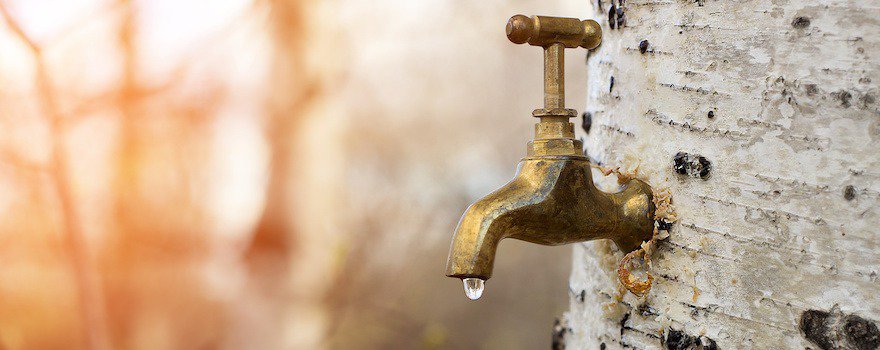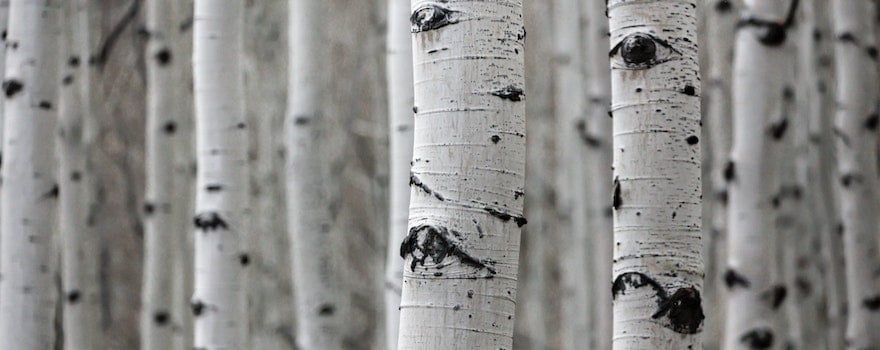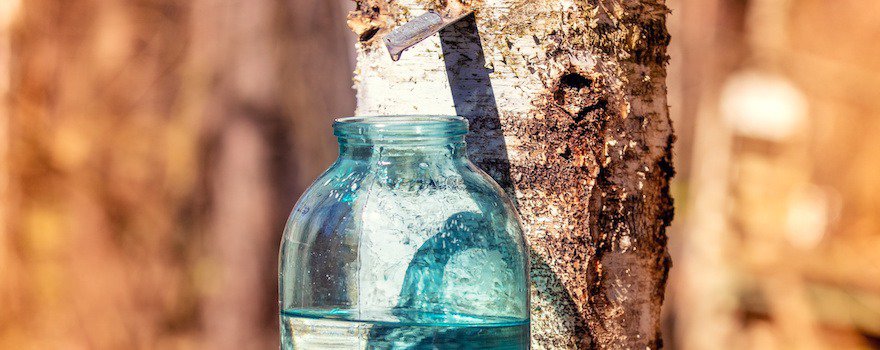BENEFITS OF BIRCH SAP
✓ Detoxifying and diuretic
✓ Provides vitality
✓ Antioxidant
✓ Relieves inflammation and pain
✓ Potentially anti-cancer
What is birch sap?
Birch sap is derived from the bark of Betula pendula, commonly called white birch, warty birch, or European birch. Considered one of the most beautiful trees, the birch is associated with purity, gentleness, renewal, and wisdom.
Among the Celts, the birch is even nicknamed the ‘tree of wisdom’. Its scientific name comes from the Celtic ‘betul‘ relating to the first lunar month and the return of spring. The birch holds a special place in many cultures, notably among the peoples of Northern Europe (Lapland, Scandinavia, Scotland…).
Belonging to the family Betulaceae, the birch is native to Europe and northern Asia. It is mainly found in cold countries (Canada, the Scandinavian and subarctic regions…) and in some countries with a temperate climate (France, the Netherlands…).

The birch is a majestic tree that can reach 30 m in height and live up to 100 years. Above all, it is an ornamental tree with green leaves that turn golden in autumn, white, shiny bark and catkin-shaped flowers.
But the birch is also a valuable tree in herbal medicine. Its leaves, buds, roots, bark and the sap extracted from it hold many benefits. Today, birch is often offered as a juice (obtained from the leaves) but it is the sap that is the most interesting part of the tree.
If birch sap is so beneficial, it’s because it contains valuable components: trace elements and minerals but also vitamins and amino acids.

Nutritional composition
- 17 amino acids : glutamine and glutamic acid, citrulline, chlorogenic acid, valine, isoleucine…
- Vitamins : A, E, D3, B1, B2, B6, B3, B9, C
- Proteins
- Heterosides : betuloside, monotropitoside
- Phenolic acids
- Sugars : glucose, fructose, galactose, sucrose, xylitol
- Fruit acids : malic acid, succinic acid, citric acid, phosphoric acid
- Minerals and trace elements : calcium, sodium, potassium, magnesium, silicon, selenium, chromium, copper, iron, manganese…
- Flavonoids
- Antioxidants
- Triterpenes including betulin
- Mucilages
The benefits of birch sap
💧Detoxifying and diuretic
The composition of birch sap makes it an ideal ally to eliminate toxins accumulated during the winter but also metabolic wastes (uric acid, urea…). To this end, it acts on the body’s excretory organs responsible for waste elimination : kidneys, liver, pancreas, skin…
The purifying and diuretic effect of birch sap is due to the synergistic action of its various components. Silicon, for example, promotes the elimination of aluminum by trapping it and directing it toward the renal pathways. At the same time, its phenolic acids act on drainage. As for betuloside, it exerts a diuretic action which, by increasing urine production, boosts the elimination process.
This study from the University of Medicine and Pharmacy of Timișoara in Romania, conducted on rats, shows that the diuretic activity of the sap is greater than that of birch buds, which are also used in herbal medicine.
⚡️Brings vitality
Besides detoxifying, birch sap revitalizes the body. And for good reason : it contains a multitude of invigorating vitamins such as vitamin C and B vitamins.
The action of vitamins is complemented by that of proteins (in the form of amino acids), which provide energy and perform many essential functions.
Finally, it contains magnesium, known to fight fatigue. As for glutamic acid, it helps energize and strengthen the immune system.
Consuming birch sap is therefore ideal for boosting the body and restoring energy after winter, in cases of fatigue, during periods of stress, or during sports practice…
This study from various Polish universities, carried out directly in the laboratory, identified the different proteins present in birch sap.
🥝 Antioxidant
Birch sap contains a significant amount of antioxidants, in various forms. Fruit acids, such as citric acid, are free radical scavengers. Thus, they protect and slow cellular aging. Polyphenols and flavonoids are also powerful antioxidants.
Vitamin C, the vitamin A (retinol) and the vitamin E present in birch water fight free radicals. Their action is all the more effective when the sap contains selenium and proteins. Indeed, vitamin E acts complementarily with selenium and vitamin A must be associated with proteins to be fully effective.
This study from the Medical University of Plovdiv in Bulgaria, conducted on rats, demonstrates the antioxidant potential of birch leaves due to their flavonoid content, also present in large quantities in the sap.
🌵 Relieves inflammation and pain
Birch sap has the particularity of containing two heterosides: betuloside and monotropitoside. These natural compounds release salicylic acid or methyl salicylate, an anti-inflammatory and analgesic substance similar to aspirin.
Monotropitoside is also present in other plants such as meadowsweet (Filipendula ulmaria) or wintergreen (Gaultheria procumbens), recognized for their pain-relieving, anti-rheumatic and anti-inflammatory effects.
It is therefore thanks to these heterosides that birch sap is able to relieve inflammation and reduce pain. It is particularly interesting in cases of rheumatism or osteoarthritis because it strengthens cartilage and joints. In this respect, its action is similar to that of turmeric.
Finally, the silicon contained in the sap is reputed to prevent osteoporosis by improving collagen production.
This study from the Orlando Health Department of Orthopedic Surgery in the United States, conducted on women, shows that silicon intake contributes to bone health and prevents postmenopausal osteoporosis.
🔬 Potentially anti-cancer
Recent studies have demonstrated the potential of birch sap in the fight against cancer. Indeed, it contains betulinic acid and betulin which act on tumor cells, induce apoptosis (programmed cell death) and inhibit the growth of cancer cells.
The activity of birch sap has notably been demonstrated in cases of colon, breast, lung and prostate cancer.
This study from the University Children’s Hospital of Ulm (Germany), conducted in humans, concludes that betulinic acid is a promising anticancer agent for the treatment of cancers.

How to consume birch sap?
Fresh birch sap
Fresh birch sap is extracted from the tree’s bark in spring, during the sap rise phase. It is then marketed in the days that follow, kept refrigerated and should be consumed quickly (within 2 to 3 weeks).
Due to the way it is harvested, fresh sap is not sold year-round. Therefore, it generally needs to be preordered to obtain.
Stabilized birch sap
Once harvested, fresh birch sap naturally tends to ferment. It then releases calcium maleate and calcium phosphate and becomes cloudy. To limit this fermentation, some manufacturers offer stabilized birch sap.
There are several stabilization methods : using alcohol, lemon juice, plant buds, or by encouraging the growth of lactic bacteria (lacto-fermentation). Avoid pasteurized sap or sap containing nitrogen because these preservation methods destroy nutrients.
Because it doesn’t ferment, stabilized sap has the main advantage of being available year-round and lasting longer. This allows for multiple cleanses throughout the year.
Why choose organic birch sap ?
Ideally, choose a birch sap certified organic, 100% pure, without preservatives, without chemical additives, not nano-filtered and not pasteurized. You can easily find it in health food and specialty stores or online.
Finally, favor sap whose traceability is guaranteed, harvested in an artisanal manner, with respect for the tree and collected as far as possible from sources of pollution.
Birch sap and medicinal plants
To enhance the detoxifying and revitalizing effect of birch sap, it is useful to pair it with ginger (Zingiber officinale) or with turmeric (Curcuma longa). These plants are both detoxifying and stimulating, in addition to improving digestion and having anti-inflammatory properties. It is not uncommon to find drinks made with birch sap and ginger.
To fight fatigue after winter, you can also pair it with spirulina (Arthrospira platensis) during your spring cleanse.
To relieve joint pain, birch sap can be combined with devil’s claw (Harpagophytum procumbens) or with boswellia (Boswellia serrata).

Dosage of birch sap
⚖️ It is generally recommended to take half a glass of birch sap per day, either pure or diluted in water.
⌛️ It is preferable to take it in the morning on an empty stomach, before breakfast. Avoid consuming birch sap in the evening because, due to its diuretic effect, you may have to get up several times during the night to urinate.
⌛️ Ideally, it should be taken as a 20 to 30 day course, at the end of winter and in spring. Of course, you can consume it year-round provided you take regular breaks because it places a lot of strain on the kidneys.
🌳 Fresh birch sap : half a glass per day.
💧Stabilized birch sap : 3 capfuls per 1 liter of water, to be drunk throughout the day.
Contraindications and side effects
Birch sap is generally well tolerated by the body. However, its consumption is not recommended for the following people :
- As a precaution, young children, pregnant or breastfeeding women should avoid taking it.
- It is not recommended for people allergic to salicylate derivatives or suffering from kidney disease.
- People taking medication (painkillers, anticoagulants, antihypertensives…) should consult their doctor before consuming it.
Taking birch sap may cause the following side effects :
- Allergic reactions.
- Nausea.
- Increased urine and stool output.
- Gastrointestinal issues (diarrhea).
If symptoms persist, stop taking it and consult a doctor.

History, cultivation, and market of birch sap
A race against time
Every year, spring heralds the start of the sap harvest ! Birch sap is extracted from the tree in March-April (generally from March 15 to April 15). It is during this period, when the birch resumes its growth phase, that the sap rises to the heart of the tree.
It’s also during this short period that the sap is richest in acids, minerals and trace elements. Researchers have even studied the seasonal variations of the acids in birch sap. After the buds open, the composition is less interesting and the sap becomes cloudy.
An ancestral harvest
In many countries, birch sap harvesting is still done in a traditional way. After cutting into the bark and making a small hole a few millimeters in diameter, the sap flows naturally.
A tube is then inserted into the hole to guide the sap into the containers. Once the harvest is finished, the hole is plugged to protect the tree from fungi and diseases. Over the following months, the trunk will heal naturally.
La récolte de sève n’a pas d’incidence sur la santé du bouleau. Au printemps, il produit quotidiennement 200 à 300 litres de sève pour répondre à ses besoins !
As part of a traditional, tree-friendly harvest, only about ten liters are collected each day. And if you have a birch in your garden, know that it is possible to harvest the sap yourself.
Today in France, many young entrepreneurs are starting to grow and market birch sap using permaculture, like this young producer from Maine-et-Loire.
Report produced by Julia Perez and Charlotte Jean
Sources and scientific studies
C. Peev, C. Dehelean, C. Mogosanu, Stefana Avram Feflea 2010. Spring drugs of betula pendula Roth: Biologic and pharmacognostic evaluation.
Maciej Bilek, Marcin Olszewski, Paweł Wityk, Paweł Staniszewski, 2019. Proteins of birch tree sap.
Penkov D, Andonova V, Delev D, Kostadinov I, Kassarova M, 2018. Antioxidant Activity of Dry Birch (Betula Pendula) Leaves Extract.
Charles T. Price, Kenneth J. Koval, and Joshua R. Langford, 2013. Silicon: A Review of Its Potential Role in the Prevention and Treatment of Postmenopausal Osteoporosis.
Simone Fulda, 2008. Betulinic Acid for Cancer Treatment and Prevention.



